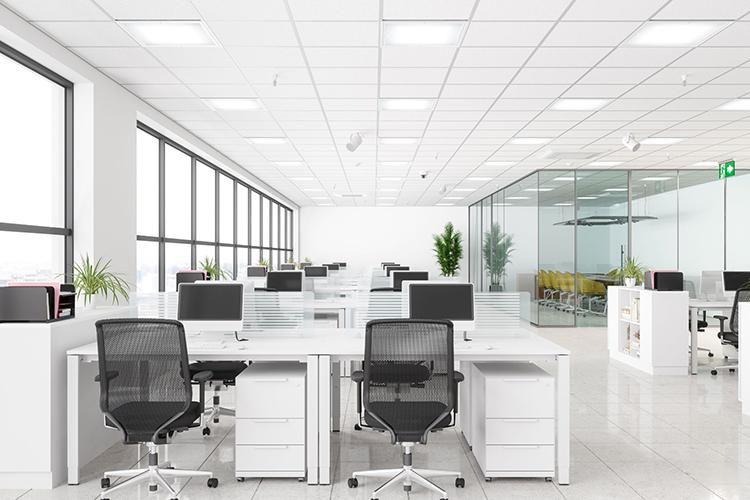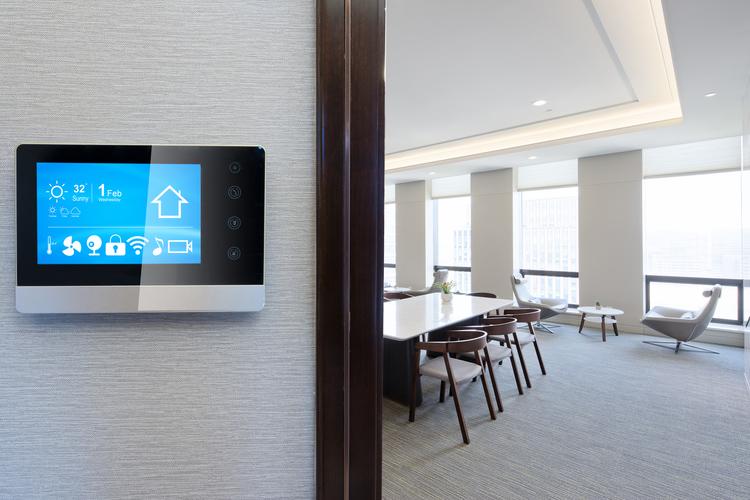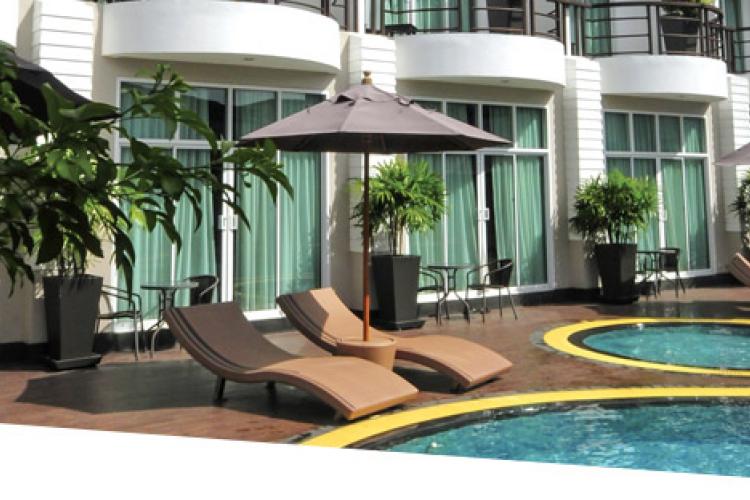Meeting Building Energy Standards With Lighting Controls Strategies
Meeting Building Energy Standards With Lighting Controls Strategies
Meeting Building Energy Standards With Lighting Controls Strategies
INTRO TO CODES, CONTROLS AND COMPLIANCE
Many businesses are just beginning to transition to LED lighting in the 5.6 million commercial buildings in the United States. While the immediate goal is energy efficiency, there are long-term implications that require a holistic approach.
The reality is that most buildings consume more energy than they should; however, national and local building codes are changing to establish narrower baseline requirements for efficient energy use in offices, high-rises, retail stores, hotels, health care facilities and all types of commercial structures.
Increasingly, codes mandate the use of lighting controls to minimize wasteful energy consumption in new and renovated buildings. The addition of sensors and control technologies enables LED lighting to increase energy savings and become an all-sensing network, compiling the data required to drive even greater efficiencies.
This guide can help you understand energy codes, what requirements are changing and how to take advantage of the benefits a lighting controls package offers.
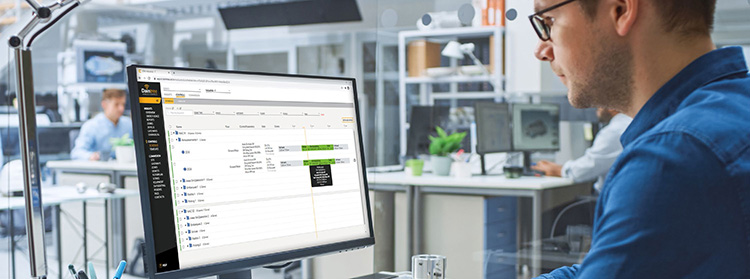
The Future is Connected
Today, there is an urgent need for energy-efficient buildings and more incentive to use lighting controls, including utility rebates for code-compliant solutions.
Facility Executive reports that connected lighting comprises less than 1% of all luminaires in the U.S.; however, with downward costs and upward innovation, this percentage is likely to grow substantially over the next two decades. The Department of Energy (DoE) estimates that by 2035, almost 33% of installed luminaires in commercial buildings will have network connectivity.1
Controls can play a key role in driving buildings toward zero-net-energy performance. Lighting (17%) is the biggest end user of electricity in commercial buildings according to the U.S. Energy Information Administration (EIA), outpacing refrigeration (16%), ventilation (16%) and cooling (15%).2 As a growing roster of enterprises commits to carbon-reduction targets, reaching these milestones will require a mix of technologies, including LED lighting and controls.
Striving for net-zero
The Office of Energy Efficiency & Renewable Energy (EERE) is already celebrating the work underway to advance buildings toward a net-zero future, including minimizing the emissions from buildings as part of a plan to achieve a carbon-free electricity sector by 2035, to which the development and adoption of net-zero buildings are key.3
Also leading the charge are nonprofit organizations like Architecture 2030, which is working to transform the built environment and how we think about resiliency. The group’s research illustrates that low- to no-carbon techniques and applications can be implemented at no incremental cost, since the evolving regulatory environment increasingly mandates their adoption.
Building energy codes seek to reduce the increasing strain on power grids, curb energy spending over the life of a structure and support improved design and construction methods. At the same time, these guidelines help to provide safe, healthy environments for occupants.
Businesses Are Buying In
A new report points to a spike in lighting control installations in recent years, partly attributable to growing awareness of energy efficiency. The commercial sector dominated the market in 2020, with offices accounting for the highest share. The global lighting control system market by revenue is expected to grow at a Compound Annual Growth Rate (CAGR) of about 19% from 2020 to 2026.
Achieving zero-energy buildings is an ambitious yet increasingly achievable goal.
This short video by the DoE explains what it means to be a net-zero building.
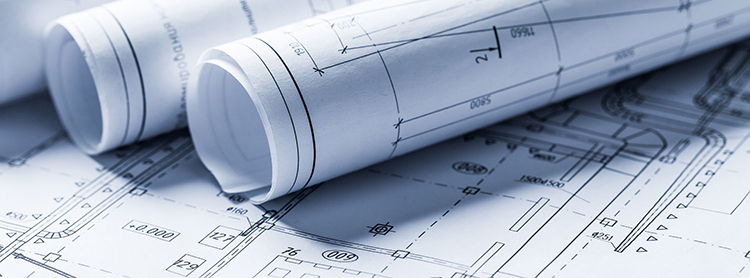
About Energy Codes
Energy codes are a subset of building codes, which establish baseline requirements for building construction. The International Energy Conservation Code®(IECC®), American Society of Heating, Refrigerating and Air-Conditioning Engineers (ASHRAE) Standard 90.1 and California Energy Commission’s (CEC’s) Building Energy Efficiency Standards – Title 24 are the most widely adopted codes throughout the U.S. In Canada, the National Energy Codes for Buildings (NECB) outlines minimum energy efficiency levels.
These codes form the basis for nearly all local standards for new construction or major renovations of commercial buildings.4
Each is periodically updated to account for improved energy technologies and practices. Reflected in each code is the importance of using lighting controls to conserve energy limits by space type. A basic lighting controls package can deliver significant energy use reductions while advanced controls have the potential to transform environments, including how people experience a space. Beyond utility savings, controls can help boost occupant comfort and employee productivity levels as part of a comprehensive approach to facility management.
Here’s a quick look at how energy codes are changing to require lighting controls and when to expect the next updates.
- IECC: Encourages and rewards the use of luminaire-level lighting controls (LLLC) for independent occupancy sensing and dimming functions. Lighting control zones smaller than 600 square feet are mandated for open office areas. The code is updated every three years, most recently in 2021.
- ASHRAE 90.1: Daylight responsive requirements now include continuous dimming for all daylight zones. ASHRAE 90.1 allows for multiple updates a year and was last revised in 2019.
- California Title 24: A major requirement is Demand Response in buildings larger than 10,000 square feet, requiring networked solutions that local energy service companies can tie into to govern energy usage during peak demand. Updated standards for the 2019 iteration of Title 24 have been proposed for adoption and are currently under review. The new Title 24 code will have an effective date of January 2023.
- Canada NECB: States that all exterior lighting must be controlled by automatic power reduction and, in some cases, have an automatic shut-off. NECB was last updated in 2015 and is now in the final stages of its next development cycle.
The DoE Building Energy Codes Program (BECP) reviews adoption of energy codes for commercial buildings. In most cases, state adoption is based on IECC and/or Standard 90.1 guidelines.
The DoE analyzes state energy codes to assess the savings associated with subsequent code updates. These findings aid model code adoption and serve to support states working to update their standards.
The BECP also makes it easy to see the current state of energy code adoption for commercial buildings for all 50 states. DoE resources are an excellent guide; however, always consult state and local listings to ensure code compliance.
Commercial Buildings
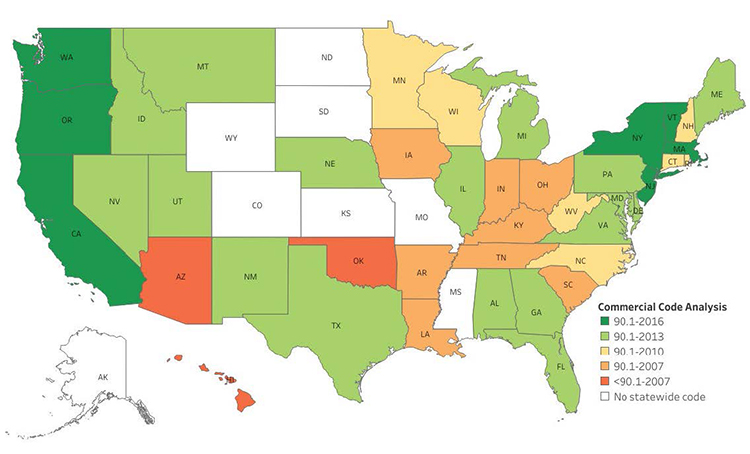
Status of state energy code adoption map summary as of Oct., 2021.
DoE resources are an excellent guide; however, always consult state and local listings to ensure code compliance.

Saving with Controls
It is getting easier to save energy and money with lighting and building controls. The growing adoption of LED lighting, combined with controls solutions, gives designers more flexibility to create lighting systems that suit the task at hand.
Importantly, when lighting and controls work in harmony, there can be optimal benefit to building energy performance. Controls help eliminate the wasted lighting energy in buildings by reducing the amount of power consumed and/or time the lighting system is in use.
Researchers at Lawrence Berkeley National Laboratory conducted meta-analysis to quantify energy savings potential from lighting controls in commercial buildings. The study used 240 savings estimates from 88 published sources to arrive at final average savings estimates of:
- 24% for occupancy
- 28% for daylighting
- 31% for personal tuning
- 36% for institutional tuning
- 38% for combined approaches
Calculated national energy savings potential was on the order of 19%.
The study shows how lighting has the largest estimated technical potential for energy savings of any U.S. building end use, of which a significant fraction is believed to lie in lighting controls. While controls are increasingly being incorporated into national model building codes, adoption and enforcement are spotty, leaving much potential untapped.5
Using Less Energy
The DoE estimates Standard 90.1-2019 will achieve national savings in commercial buildings of approximately 4.7% site energy, 4.3% source energy, 4.3% energy cost and 4.2% carbon emissions versus the 2016 standard. This determination shows how codes often change to benefit from technology improvements.
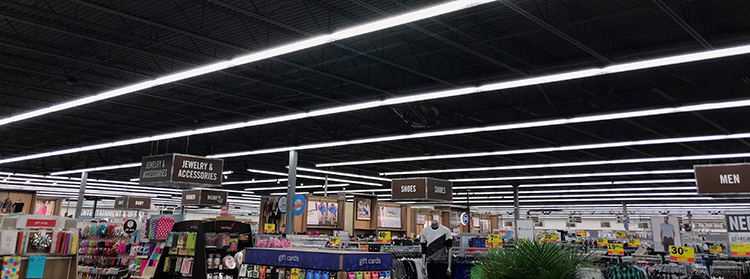
Solutions to Build On
Many lighting projects require standard control of fixture switching, dimming and scheduling. Others are more ambitious, aiming to create a scalable digital infrastructure capable of driving business productivity and IoT outcomes.
Our experts know how to implement a complete LED lighting and controls strategy that considers the many factors impacting a building’s energy performance. We also make it simple to choose the right controls package that is easy to install and operate.
Wireless convenience
Wireless controls provide the functionality and flexibility that are required to meet different energy codes, while minimizing installation time and expense. Daintree® wireless controls and sensors from Current can be integrated into LED fixtures to provide independent control of each luminaire. This saves on-the-job labor, avoids the need to get above the ceiling to install extra devices and helps maintain the design integrity of the space.
We can help you determine which codes apply and the best solution for your needs. The following scenarios show how a single LED fixture can be programmed differently using Daintree® EZ Connect app-based room controls to meet the requirements dictated by the code in those spaces.
- Auto On/Off
- Is typically required in spaces that are vacant for periods of time but must respond quickly to occupants’ movement.
- With Daintree® EZ Connect: Fixtures can automatically cycle between Off (0% output), Standby (0%–50%), Background (0%–50%) and Task (0%–100%) state light levels when motion is detected, depending on whether the occupant remains in the space. This helps reduce energy costs and improve occupant satisfaction.
- Some codes allow for auto-on to 50% brightness based on occupancy. Full brightness is allowed with manual-on functionality.
- Manual On/Auto Off
- Adds a layer of independent control to help meet energy code requirements in rooms that are rarely occupied.
- With Daintree® EZ Connect: Switches the system to the Off state when no motion is detected, requiring lights to be manually turned on via a switch control before the system will resume full-on 100% lighting brightness.
- Daylight Harvesting
- Requires fixtures in certain zones to change their light output based on ambient light levels throughout the day.
- With Daintree® EZ Connect: The system can automatically cycle between states to achieve optimal energy efficiency in locations that benefit from large windows or skylights, from sunup to sundown.
Beyond lighting control
A networked controls solution can provide significant energy savings not only across an entire building, but also multi-site locations. Companies can gain additional savings from other building management systems (BMS) devices like HVAC, plug load and fan optimization.
Such connected platforms can also support app-based data-collecting programs like heat mapping, people counting, asset tracking and location-based services to improve space utilization.
Controls and sensors can work in tandem to monitor energy usage based on occupancy. By collecting data these networked solutions can go beyond helping save energy, but can also mine data, such as people counting, which can be used to enhance productivity and help improve safe distancing protocols when returning to work. The open architecture and read/write capabilities of the Daintree® Networked system allow for integration with third-party devices and applications, providing the ability to expand your control beyond lighting and into the world of IoT to create intelligent environments.
Lighting Controls From Current
We’ll connect you to a solution that’s right for your business to future-proof your buildings, whether your goal is saving energy or growing your digital infrastructure.
Wireless
- Daintree® One: Offers single-fixture control for individual luminaires in locations that do not require lighting coordination and communication, such as small offices and warehouses.
- Daintree® EZ Connect: A mobile, app-based solution that provides zonal control and simple commissioning of lighting fixtures for room-based lighting programming.
- Daintree® Networked: Provides the infrastructure for feature-rich commercial whole-building or multi-site lighting control, including interconnectivity with other building management systems such as HVAC, plug load control, fans, water heaters, air compressors and refrigeration units.
Multi-site
- Daintree® Networked can manage multiple sites and campuses using Daintree® Controls Software (DCS), a data-rich software platform that allows convenient management of smart building networks and multi-site locations, with graphic visualization of data points in a building on the Daintree® Networked solution.
Outdoor
- Daintree® WANSI Nodes control area lights with a 5- or 7-pin ANSI receptacle. The node can zone, dim and schedule outdoor lighting on the Daintree® Networked platform.
Wired
- LightSweep® is a modular and scalable lighting control solution for meeting specification without having to overengineer the control design and is adaptable to single spaces or multiple facilities.

Take Control of Your Buildings
The bottom line is that lighting controls reduce energy use and will become more entrenched in building codes moving forward. Start by asking questions about the energy savings goals for your space and where functions like dimming and daylighting will be required. Let these answers inform your lighting controls strategy and guide your project from concept to commissioning, even as budgets change and designs are modified.
Not designing to code on permitted jobs can impede you from obtaining a certificate of occupancy, which can delay a project by months or even years. Minimize your risk potential with a comprehensive plan for meeting current and anticipated needs. Many of today’s digital lighting controls solutions are upgradable and scalable in response to new demands.
Available rebates
Rebates for lighting projects are still going strong at the local and national levels. Currently, 74% of the country is covered by an active commercial lighting rebate program according to BriteSwitch, an organization dedicated to helping businesses take advantage of incentive programs throughout the U.S. and Canada.
We’ve also made it easy to find utility rebates for LED lighting and controls in your area. Rebate amounts vary but can offset total product cost by 15%–25% in many cases.
Ask an Expert
Energy codes can be difficult to decipher or, at times, are downright confusing. Keeping up with the latest energy and building code revisions can seem like a daunting task. A knowledgeable partner versed in national and local code language can help you think through various scenarios and avoid oversights that may sidetrack your project down the road.
We are a partner to hundreds of commercial businesses that have invested in smarter buildings and welcome the opportunity to discuss your goals. Current delivers proven solutions for energy-compliant buildings accompanied by experts that know how to keep your project on schedule.
Let’s talk about codes and controls.
Case Studies
These companies took control of their lighting management strategy with the use of the latest solutions from Current.
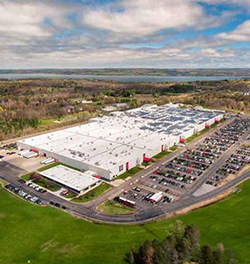
Cummins Drives Savings With Controls
- Challenge: Help Cummins Inc. reduce lighting costs at the 1 million-square-foot Jamestown Engine Plant (JEP).
- Solution: Daintree® Wireless Controls integrated with Albeo® LED high bay fixtures. JEP gains automatic dimming, scheduling and demand response capabilities.
- Result: Exceeded energy savings goal of $400,000 in year one and earned $1.5 million in National Grid New York rebates―$736,000 attributable to the new lighting and controls.

Stop & Shop® Upgrades Its Stores
- Challenge: Implement LED lighting control in Stop & Shop stores across the U.S. to cut energy use and help inform decision-making.
- Solution: LED luminaires with built-in occupancy and daylight sensors that are compatible with Daintree® Wireless Controls.
- Result: Annual energy savings of 30% due to new lighting and additional 36% savings from controls, plus more data insights that can drive a better customer experience.
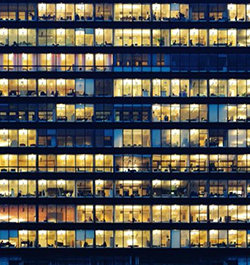
Transwestern Transforms Large Office
- Challenge: Equip Transwestern Real Estate’s 12-story multitenant office building and three-story garage with an advanced lighting controls package.
- Solution: Daintree® Wireless Controls integrating over 3,400 lighting fixtures from the lobby to the office to the parking deck, allowing custom lighting profiles by zone and maximized energy savings from unoccupied spaces.
- Result: $155,000 energy savings and $20,000 maintenance cost reduction per year and a new holistic view of the building’s lighting energy consumption.
Helpful Resources
Learn more about codes and controls by exploring these free resources including detailed room-by-room and zone-by-zone instructions.
Available from Current
More assistance
- Daintree® and LightSweep® Overview
(explore more features, capabilities and benefits) - Integrated Fixture Guide
(see all Current fixtures with built-in wireless control) - Daintree® EZ Connect
(room-based control for commercial lighting) - Daintree® Networked
(take control of multi-site lighting) - Technical Support
(ask us anything)
Common Terms
The following can help you understand how energy codes and lighting controls relate.
Strategies
- Control Schemes: Different approaches help ensure light is delivered at the right levels to specific building areas.
- Zonal: This scheme groups multiple lighting fixtures together as a single control group, which requires fewer sensors and edge equipment. Zonal control groups are fixed in place and must be recommissioned if changes are necessary.
- Granular: This design provides independent control of fixtures with integrated sensors and requires the least amount of effort to deploy. Granular control allows the highest level of flexibility and energy efficiency as lighting zones can be assigned to individual fixtures. These smaller zones can be redefined and reprogrammed.
- Occupancy Settings: Energy codes may require the use of sensors to detect people in an area.
- Occupancy: Detects and alerts the system with the presence of people in a given area.
- Vacancy: Detects and alerts the system when people are no longer in a given area.
- Full Auto-On: Automatic control involves an occupancy sensor that turns the lights to full brightness when occupancy is detected. Light levels can be overridden with a dimmer switch.
- Full Auto-Off: Also referred to as Vacancy detection, turns the lights off after a set time. California Title 24 requires Full Auto-Off after 20-minute vacancy in most common spaces.
- Partial Auto-On: Lights will automatically turn on to a set light level when a room has occupancy. Light levels can be adjusted by the user with a manual control.
- Manual-On: Lights do not turn on to full brightness until occupant turns the light switch on.
- Auto-Partial Off: In certain environments (such as open offices or egress stairwells), it is allowed and desirable to dim lights rather than turn them off when the area is vacant.
Requirements
- Daylight Harvesting (Daylight Responsive Control): Requires lights near windows and skylights to dim automatically and take advantage of sunlight entering the building. Photosensors are needed in each zone to ensure light levels are consistent across work surfaces.
- Demand Response: The control system has the capability of automatically reducing lighting power when a participating utility sends a peak demand signal.
- Dimming: Reduces light levels in response to daylight conditions as well as occupancy/vacancy to conserve energy. Allows occupants to set desirable light levels.
- Lighting Power Density (LPD): Defines the maximum allowable lighting wattage that can be used in a space (watts/sq. ft.).
- Manual Control: Provides a switch and/or dimmer that overrides automatic and scheduled lighting behavior. Manual control is necessary in most areas but not all.
- Plug Load Control: Is concerned with managing/minimizing the total energy used by equipment that is plugged into an outlet (e.g., computers, printers, portable lighting).
- Scheduling: Adjustment of lighting behavior based on normally occupied days/times. This is often in lieu of occupancy controls in areas (e.g., atriums) that may not be conducive to occupancy sensors.
- Top Trimming: Limits the maximum light level output of LED luminaires to save additional energy and extend the life of the chips and driver.
Componentry
- Luminaire: Another word for a complete lighting unit or fixture.
- Node: A device typically serving as a connection or communication point in a larger network.
- Sensor: Any device that detects or measures physical changes to an environment.
- Wireless Adapter: Hardware that enables traditional wired devices to communicate wirelessly within the network that can be used in conjunction with devices such as sensors, LED drivers, ballasts and switches.
- Wireless Area Controller (WAC) or Gateway: Hardware that manages the wireless network, contains the control algorithms that convert sensing data into commands to ballasts and luminaires, tracks devices and stores their states, and detects issues and repairs the system.
Attribution
- Facility Executive; “Trends in Lighting Controls”; published April 23, 2021.
- U.S. Energy Information Administration (EIA); “Use of energy explained: Energy use in commercial buildings”.
- Office of Energy Efficiency & Renewable Energy; “Net-Zero Buildings Week: Commercial Buildings”; March 31, 2021.
- LEDs Magazine; “Lighting control requirements will drive building energy reduction”; Sept. 25, 2014.
- Williams, A., Atkinson, B., Garbesi, K., Page, E. & Rubinstein F., 2011. “A Meta-Analysis of Energy Savings from Lighting Controls in Commercial Buildings.” LBNL-5095E. Berkeley, Calif.: Lawrence Berkeley National Laboratory; https://ees.lbl.gov/publications/meta-analysis-energy-savings-lighting
Additional Reference
- California Energy Commission; “2019 Building Energy Efficiency Standards for Residential and Nonresidential Buildings for the 2019 Building Efficiency Standards”; date online: Dec. 12, 2018.
- Lighting Controls Association; “Quick Guide to the Latest Commercial Building Energy Code Standards”; June 19, 2019.
- ReportLinker.com; ”Lighting Control System Market – Global Outlook & Forecast 2021–2026”; May 2021.
- U.S. Department of Energy; “Building Energy Codes Program: 2021 IECC Commercial Building Envelope Changes”; presented Oct. 29, 2020.
- U.S. Department of Energy; “Building Energy Codes Program: 90.1-2019 Lighting Updates”; presented Jan. 23, 2020.


